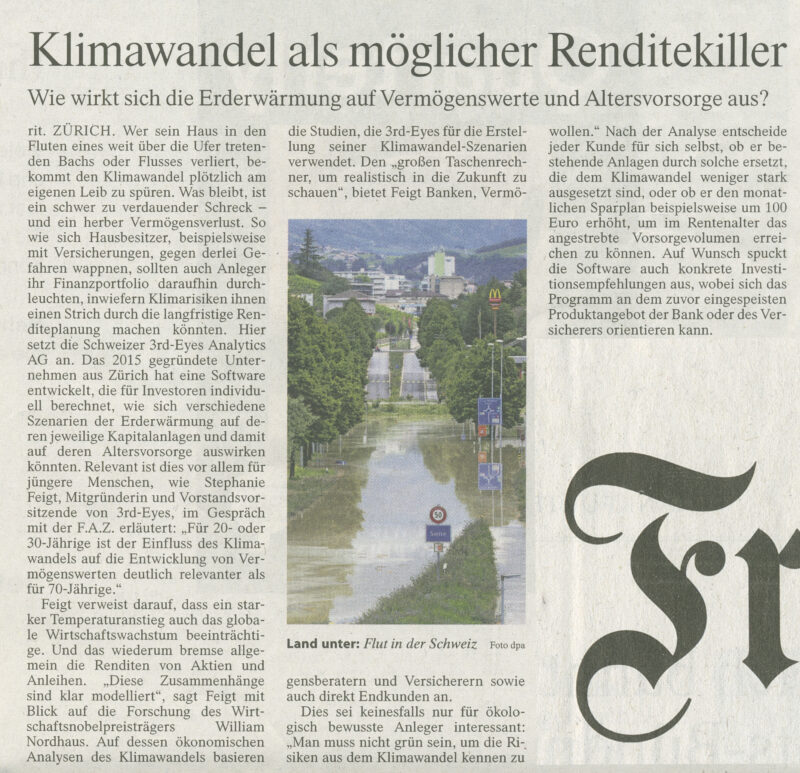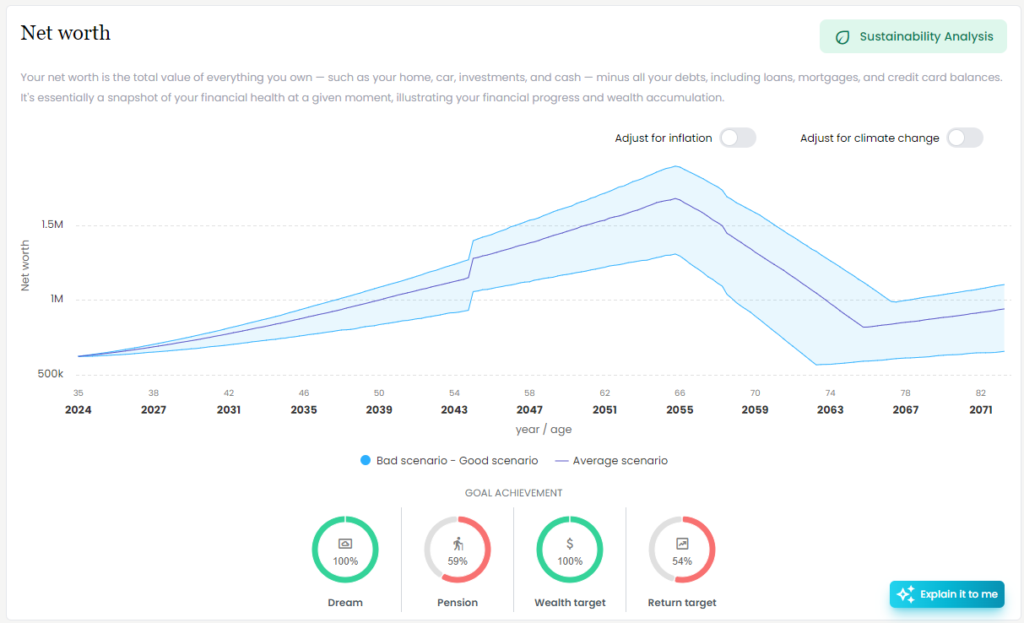It is essential to consider the effects of inflation and climate change in wealth planning. As Felix Csajka, Head Investments at 3rd-eyes analytics, points out, only by taking these factors into account can a realistic outlook on wealth development be gained.
Mr Csajka, a realistic simulation of client wealth should, on the one hand, take into account the risks of climate change in the investment strategy and at the same time allow for a sustainable reduction of CO2 emissions. On the other hand, investors are currently afraid of inflation in particular. How can both risks be adequately included in wealth planning?
Felix Csajka: We do this by taking into account the long-term inflation expectations of the market in addition to the risks of climate change. These flow into the long-term return estimates of the asset classes, so inflation is additionally factored into future payment flows, e.g. for a pension payment or a purchase.
What does that mean specifically?
Csajka: This is best illustrated with an example of a pension payment. Let’s take a 35-year-old woman with a statistical life expectancy of 84 years who is aiming for a monthly payment of 1750 euros as an additional pension. She calculates that by the time she retires in 2054, she will have saved assets of 150,000 euros, consisting of one third each of equities, bonds and cash. Using our simulation calculator at 3rd-eyes analytics, we unfortunately have to inform the lady that she is still 63,195 euros short of her goal achievement plan or, alternatively, that the saved assets will have been used up earlier. Taking into account the loss of purchasing power due to inflation, according to our calculations the calculated assets will already be used up in 2063 at the age of 76. The imputed shortfall for the initial assets is 173,329 euros.
But this does not even take into account the consequences of climate change.
Csajka: That is unfortunately true. The consequences of climate change further exacerbate this situation. Assuming an increase in the global mean temperature of three degrees – twice as much as targeted in the Paris Climate Agreement – the base scenario results in a shortfall of 243,356 euros. If the lady does not save anything extra and only has the calculated 150,000 euros at her disposal when she retires and withdraws 1750 euros every month, this would already be used up in 2061 at the age of 74. This example shows impressively that the risks of climate change and inflation must be taken into account in wealth planning.
The harsh alternative would be a lower supplementary pension?
Csajka: Exactly, which is why we at 3rd-eyes analytics are firmly convinced that it is absolutely necessary not to neglect these factors due to their drastic influence on a client’s personal situation, for example, in order to avoid the danger of old-age poverty by taking countermeasures at an early stage.
What parameters do you use for this?
Csajka: We look at the market’s inflation expectations and also take inflation volatility into account. The background is that the market’s long-term inflation expectations are more relevant and these are also rising, but not nearly as dramatically as the inflation figures we are currently seeing in the US and the EU. Long-term inflation expectations, which can be seen in inflation swaps, for example, are 2.5 per cent for 20 years in the US and the euro area. Short-term expectations are somewhat higher. We are currently orienting ourselves towards the long-term values, but expect higher inflation rates in the medium term, not least again due to climate change, as temperature fluctuations and the imperative switch to renewable energies will bring foreseeable price increases.
Can inflation be predicted accurately at all? And what are the influencing factors?
Csajka: In principle, inflation can be predicted relatively well because the driving forces are known. However, we also know that there can be structural breaks, such as in the financial crisis. Important drivers are the development of energy prices and exchange rate pegs. However, per capita income (GDP) and credit growth also have an influence.
What does this ultimately mean for investors? To what extent can they take inflation into account in their portfolio decisions?
Csajka: Inflation initially means a loss of value for investors. They should definitely take the inflation trend into account, not least to protect the purchasing power of their investments. A good solution for this is to overweight tangible assets and limit fixed-interest securities to the individually appropriate minimum, with the exception of inflation-protected bonds. In the case of equities, preference should be given to stocks with stable cash flow over growth stocks.
And what is your personal longer-term assessment of the inflation trend?
Csajka: We might have to face a longer regime with higher inflation. Central banks are currently sharply raising interest rates to fight inflation. This gives legitimate hope that with these measures inflation can be contained in the new year. However, the current situation shows the urgency of including price increases in wealth planning and actively bringing about portfolio decisions that serve to protect against inflation. Because quite fundamentally, we must expect somewhat higher inflation in the future – if only because of the transition to green energy. Ultimately, however, we also expect higher volatility in inflation, as a greater number of extreme weather events, in addition to geopolitical conflicts and other factors, can have an increasing impact on energy and food prices.
Dr. Félix Csajka, CFA:
Dr Félix Csajka has more than 20 years of experience in asset management and has been Head Investments at 3rd-eyes analytics since 2019. In previous positions, he worked for GAM, Clariden Leu and Bank Hofmann in Zurich, among others. Dr Csajka holds a degree in natural sciences from ETH Zurich and a PhD in statistical mechanics from the University of Berkeley.










